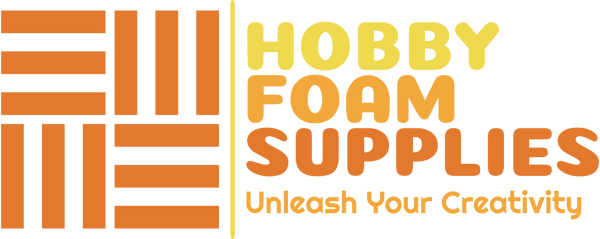Top 10 Popular XPS Foam Craft Styles
XPS foam is a versatile and durable material that's perfect for a wide range of crafting projects. Here are the top 10 popular XPS foam craft styles, along with their suitability for different age groups, specific examples, the scientific branches involved, long-term benefits, and difficulty level:
1. 3D Terrain and Scenery
- Age Range: 13 - 65
- Difficulty: Intermediate to Advanced
- Why it's popular: This hobby allows for detailed and realistic creations, appealing to teens and adults who enjoy intricate projects.
- Examples: Miniature landscapes, fantasy terrain, historical battlefields
-
Science behind it:
- Geography: Understanding topography, landforms, and climate
- Geology: Understanding rock formations, soil types, and mineral deposits
- Botany: Understanding plant life and ecology
- Long-term benefits: Improved spatial reasoning, problem-solving skills, attention to detail, and creativity.
2. Props and Cosplay
- Age Range: 13 - 20
- Difficulty: Intermediate to Advanced
- Why it's popular: Cosplaying allows for self-expression and creativity, especially appealing to teens and adults who enjoy dressing up and role-playing.
- Examples: Swords, shields, armour, helmets, wings
-
Science behind it:
- Materials Science: Understanding the properties and behaviour of materials
- Engineering: Understanding the principles of design, construction, and mechanics
- Long-term benefits: Improved creativity, problem-solving skills, hand-eye coordination, and technical skills.
3. Architectural Models
- Age Range: 10 - 70
- Difficulty: Intermediate to Advanced
- Why it's popular: This hobby requires precision and attention to detail, making it suitable for older children and adults who enjoy technical challenges.
- Examples: Scale models of buildings, cities, and historical landmarks
-
Science behind it:
- Architecture: Understanding the principles of design, structure, and function
- Engineering: Understanding the principles of construction and materials science
- History: Understanding the historical context of buildings and structures
- Long-term benefits: Improved spatial reasoning, problem-solving skills, attention to detail, and historical knowledge.
4. Wall Art and Sculptures
- Age Range: 8 - 60
- Difficulty: Beginner to Intermediate
- Why it's popular: This hobby allows for artistic expression and creativity, appealing to children and adults who enjoy visual arts.
- Examples: 3D wall hangings, sculptures, and murals
-
Science behind it:
- Art and Design: Understanding principles of composition, colour theory, and perspective
- Materials Science: Understanding the properties of materials and how they can be manipulated
- Long-term benefits: Improved creativity, problem-solving skills, fine motor skills, and spatial awareness.
5. Costume Elements
- Age Range: 8 - 18
- Difficulty: Beginner to Intermediate
- Why it's popular: This hobby allows for self-expression and creativity, especially appealing to children and adults who enjoy dressing up and role-playing.
- Examples: Wings, headpieces, armour, and weapon props
-
Science behind it:
- Materials Science: Understanding the properties and behaviour of materials
- Engineering: Understanding the principles of design, construction, and mechanics
- Long-term benefits: Improved creativity, problem-solving skills, hand-eye coordination, and technical skills.
6. Miniature Worlds
- Age Range: 7-80
- Difficulty: Beginner to Intermediate
- Why it's popular: This hobby allows for imagination and creativity, appealing to children who enjoy building and designing.
- Examples: Fairy gardens, dollhouses, and miniature villages
-
Science behind it:
- Scale and Proportion: Understanding how to represent objects at a smaller scale
- Design: Understanding principles of composition, colour theory, and perspective
- Long-term benefits: Improved spatial reasoning, problem-solving skills, attention to detail, and creativity.
7. Foam Board Art
- Age Range: 6-80
- Difficulty: Beginner
- Why it's popular: This hobby is easy and accessible, making it suitable for children of all ages.
- Examples: 3D sculptures, dioramas, and abstract art
-
Science behind it:
- Geometry: Understanding shapes, angles, and spatial relationships
- Art and Design: Understanding principles of composition, colour theory, and perspective
- Long-term benefits: Improved creativity, problem-solving skills, hand-eye coordination, and technical skills.
8. Vehicle Models
- Age Range: 8-80
- Difficulty: Intermediate
- Why it's popular: This hobby allows for precision and attention to detail, appealing to children and teens who enjoy technical challenges.
- Examples: Scale models of cars, planes, and spaceships
-
Science behind it:
- Engineering: Understanding the principles of design, construction, and mechanics
- Physics: Understanding the principles of motion, force, and energy
- Long-term benefits: Improved spatial reasoning, problem-solving skills, attention to detail, and technical skills.
9. Educational Models
- Age Range: 8-25
- Difficulty: Beginner to Intermediate
- Why it's popular: This hobby allows for learning and understanding complex concepts, appealing to children and teens who enjoy educational activities.
- Examples: Models of cells, planets, and historical structures
-
Science behind it:
- Biology, Chemistry, Physics, or History: Understanding the specific subject matter
- Long-term benefits: Improved understanding of scientific concepts, critical thinking skills, and creativity.
10. Custom Furniture
- Age Range: 13 - 65
- Difficulty: Intermediate to Advanced
- Why it's popular: This hobby allows for creativity and problem-solving, appealing to teens and adults who enjoy DIY projects.
- Examples: Custom tables, shelves, and decorative objects
-
Science behind it:
- Engineering: Understanding the principles of design, construction, and materials science
- Design: Understanding principles of aesthetics, ergonomics, and function
- Long-term benefits: Improved creativity, problem-solving skills, technical skills, spatial reasoning, and practical life skills.
CAUTION : Safety First:
- Always wear protective gear: Safety goggles, gloves, and a mask can protect you from dust and debris.
- Use sharp tools with caution: Always cut away from your body and use a cutting mat to protect your work surface.
- Ventilation is key: Work in a well-ventilated area to avoid inhaling fumes from paints, adhesives, and cutting processes.

